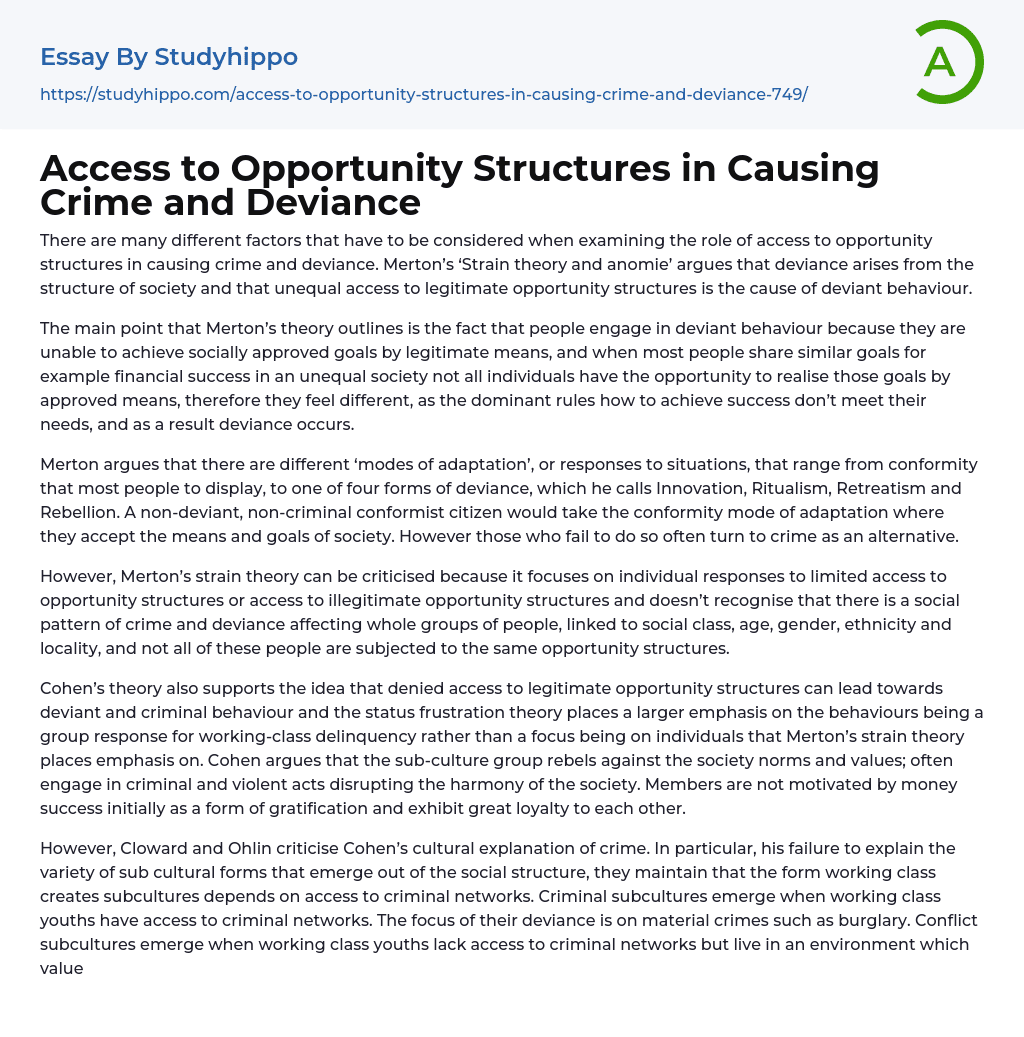

Access to Opportunity Structures in Causing Crime and Deviance Essay Example
There are many different factors that have to be considered when examining the role of access to opportunity structures in causing crime and deviance. Merton’s ‘Strain theory and anomie’ argues that deviance arises from the structure of society and that unequal access to legitimate opportunity structures is the cause of deviant behaviour.
The main point that Merton’s theory outlines is the fact that people engage in deviant behaviour because they are unable to achieve socially approved goals by legitimate means, and when most people share similar goals for example financial success in an unequal society not all individuals have the opportunity to realise those goals by approved means, therefore they feel different, as the dominant rules how to achieve success don’t meet their needs, and as a result deviance occurs.
Merton argues that there are different ‘modes of adaptation’, or re
...sponses to situations, that range from conformity that most people to display, to one of four forms of deviance, which he calls Innovation, Ritualism, Retreatism and Rebellion. A non-deviant, non-criminal conformist citizen would take the conformity mode of adaptation where they accept the means and goals of society. However those who fail to do so often turn to crime as an alternative.
However, Merton’s strain theory can be criticised because it focuses on individual responses to limited access to opportunity structures or access to illegitimate opportunity structures and doesn’t recognise that there is a social pattern of crime and deviance affecting whole groups of people, linked to social class, age, gender, ethnicity and locality, and not all of these people are subjected to the same opportunity structures.
Cohen’s theory also supports the idea that denied access to legitimate opportunit
structures can lead towards deviant and criminal behaviour and the status frustration theory places a larger emphasis on the behaviours being a group response for working-class delinquency rather than a focus being on individuals that Merton’s strain theory places emphasis on. Cohen argues that the sub-culture group rebels against the society norms and values; often engage in criminal and violent acts disrupting the harmony of the society. Members are not motivated by money success initially as a form of gratification and exhibit great loyalty to each other.
However, Cloward and Ohlin criticise Cohen’s cultural explanation of crime. In particular, his failure to explain the variety of sub cultural forms that emerge out of the social structure, they maintain that the form working class creates subcultures depends on access to criminal networks. Criminal subcultures emerge when working class youths have access to criminal networks. The focus of their deviance is on material crimes such as burglary. Conflict subcultures emerge when working class youths lack access to criminal networks but live in an environment which values defence of territory and violence.
The focus of their deviance is gang related ‘warfare’ and Retreatist subcultures emerge when working class youths are denied access to criminal or conflict subcultures. The focus of their deviance is on alcohol and drug abuse. In conclusion, even though all of these theories provide evidence for the role of opportunity structures in causing crime and deviance, being the unequal access to legitimate structures and the access of illegitimate structures leading towards criminal and deviant behaviour.
It can be argued that access to opportunity structures do not fully explain causes for all deviant behaviours and cannot be seen to
play the full role in deviant and criminal behaviour. These theories do not provide reasoning for individuals who are exposed only to legitimate opportunity structures yet still engage in deviant and criminal behaviour. Therefore, there must be other factors also contributing to the role of these behaviours, but the role of opportunity structures can be seen to contribute largely to causing criminal and deviant behaviour.
- Feminism essays
- Animal Rights essays
- Animal Testing essays
- Bullying essays
- Abortion essays
- Abuse essays
- Immigration essays
- Poverty essays
- Human Rights essays
- Inequality essays
- Violence essays
- Torture essays
- Crash essays
- Assault essays
- Racism essays
- Prejudice essays
- Controversial Issue essays
- Cyber Bullying essays
- Women's Suffrage essays
- Women'S Rights essays
- Women Empowerment essays
- Sojourner Truth essays
- Bullying In Schools essays
- Pro Choice essays
- Pro Life essays
- Should Abortion Be Legal essays
- Against abortion essays
- Abortion Debate essays
- Abuse Support essays
- Child Abuse essays
- Alcohol Abuse essays
- Physical Abuse essays
- Sexual Abuse essays
- Substance Abuse essays
- Migration essays
- Human Migration essays
- Illegal Immigration essays
- Immigrants essays
- Refugee essays
- Overpopulation essays
- Homelessness essays
- Hunger essays
- Dumpster Diving essays
- Homelessness In America essays
- Euthanasia essays
- Assisted Suicide essays
- Censorship essays
- Gun Control essays
- Empowerment essays
- Civil Rights essays



